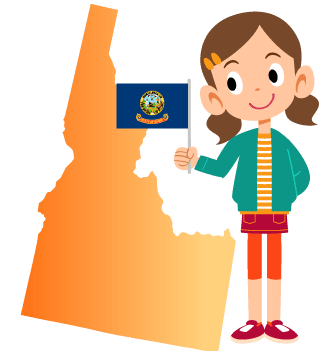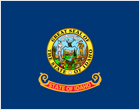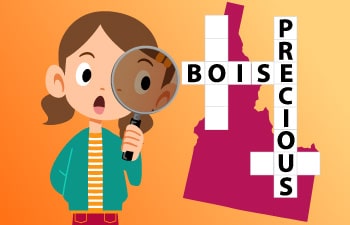What is Idaho’s state animal? Idaho’s official state animal is the Appaloosa horse. How did Idaho get its name? The origin of the name “Idaho” is actually unknown, but some people believe that the name came from a Native American word meaning “gem of the mountains.”
This may be where the state’s nickname, “The Gem State,” originated, or it could refer to the gems and precious metals that have been mined in Idaho’s mountains throughout its history. In fact, Idaho has produced about 70 types of gemstones, such as amethysts, diamonds, rubies, opals, and star garnets.
Want to learn more interesting facts about Idaho, including historical facts about Idaho, an Idaho history timeline, geography facts and more? Keep on reading our Idaho unit study supplement! Time4Learning members can download our list of PreK-12 interactive activities that align with your study of Idaho. Here are a few Idaho facts for kids:
Idaho Fast Facts
|
Became a State: |
July 3, 1890 |
|---|---|
|
Order it Joined the Union: |
43rd state |
|
State Capital: |
Boise |
|
State Abbreviation: |
ID |
|
Border States: |
|
|
State Flag: |
|
|
State Song: |
|
|
State Flower: |
Syringa |
|
State Nickname: |
|
|
Notable Idahoans: |
|
Historical Facts About Idaho
Let’s begin exploring historical facts about Idaho. Idaho’s early people inhabited the land more than 13,500 years ago. Thousands of years later, Idaho was home to the Native American tribes of the Coeur d’Alene, Blackfeet, Bannock, Nez Percé, Shoshone, and Kootenai.
Many Native Americans lived as extended families and friends, and many traveled to follow sources of hunting and opportunities for fishing and gathering. Some built large settlements on the major rivers to take advantage of the salmon runs and other fishing. Many Native Americans still live in Idaho today.
During their famous journey to explore lands west of the Mississippi River, Meriwether Lewis and William Clark were the first non-native people to explore the area in 1805.
Idaho was originally part of the Oregon country, claimed by Spain and then by Russia, the US, and Great Britain. The region continued to be claimed by both the US and Great Britain until 1846 when the land was transferred to the US as a result of both countries signing the Oregon Treaty.
Idaho became part of the Oregon Territory, with a section becoming part of the Washington Territory, until it became its own territory in 1863 (as a result of the Idaho gold rush in 1860). Idaho became the 43rd state in 1890.
Learn important historical facts about Idaho through the events outlined in this Idaho history timeline.
1743
Rocky Mountains were discovered somewhere near Yellowstone Park by Pierre De la Verendrye1805
Area was first explored by Meriwether Lewis and William Clark1809
British built the first trading post at Lake Pend Oreille1819
Treaty with Spain established the southern border at the 42nd parallel1843
Oregon Trail was established in Idaho1846
Oregon Treaty was signed, transferring land to the US, ending claims by Great Britain, and establishing the northern border at the 49th parallel1848
Region became part of the Oregon Territory; many gold seekers passed through Idaho as a result of the California gold rush1853
Part of Idaho became included in the Washington Territory (with the rest remaining in Oregon Territory)1860
Discovery of gold in Idaho, followed by a rush of settlers1863
Became its own Idaho Territory, with its capital at Lewiston1864
Capital of Idaho Territory was moved by the legislature to Boise1879
Sheepeater Indian War, where members of the Bannock and Tukuarika tribes lived on sheep they killed during raids (battles fought at Big Creek and Loon Creek with Indian surrender on September 1)1882
Northern Pacific railroad was completed across the northern part of the territory1883
Oregon Short Line was completed through southern Idaho1886
Construction was completed on the Territorial Capitol Building1890
Idaho became the 43rd state in the US under President Benjamin Harrison1896
Idaho became one of the first states in the country to give women the right to vote1905
Construction of new capitol building in Boise was authorizedBring history and geography to life with Time4Learning’s interactive online social studies curriculum for grades 2-12.
Idaho Geography Facts
After learning some interesting facts about Idaho’s history, let’s look at what features make up this great state. Idaho’s geography varies from mountains to plateaus to valleys and river basins with some 2,000 lakes. The Rocky Mountains span across the north and central parts of the state, including Idaho’s “panhandle,” and contain glacial trenches and deep canyons. In fact, the deepest gorge in North America, even deeper than the Grand Canyon, is Idaho’s Hells Canyon (7,900 feet).
Idaho is home to distinct plant and animal life, including the largest grouping of western white pines (state tree) in North America. Idaho’s tallest white pine stands at 219 feet! Other trees common to Idaho are the Douglas fir, ponderosa pine, western hemlock, and western redcedar, and wildflowers cover the state, such as pinkfairies, trillium, sticky purple geraniums, crown-vetch, and orange daylilies.
Idaho, however, is most known for its large mammals, including woodland caribou, bighorn sheep, elk, mule deer, moose, grizzly bears, gray wolves, and black bears. Those who look may also find smaller gophers and ground squirrels, 400 species of birds, and various salamanders, frogs, turtles, lizards, and snakes.
Be sure to check out this map of Idaho to get an overall view of the state. Then read through the following Idaho geography facts. Print out the map of Idaho provided below and add these items to the map.
- Idaho is bordered by Canada (British Columbia) in the north, Nevada and Utah in the south, Washington and Oregon in the west, and Montana and Wyoming in the east.
- The capital, Boise, lies in the southwestern corner of the state on a tributary of the Snake River, the Boise River.
- The Snake River comes into Idaho through Wyoming, flows westward across the southern section of the state, and then northward along the border with Oregon and into Washington.
- Lake Pend Oreille is in the northern part of the state.
- Bear Lake is in the southeasternmost corner of Idaho, shared with the state of Utah.
- Bitterroot National Forest is shared between Idaho and Montana.
- The Salmon River Mountains can be found in the central part of Idaho, south of the Salmon River (which separates the northern and southern sections of Idaho).
- Yellowstone National Park is located where Idaho meets Montana and Wyoming (and is mostly within Wyoming).
- Shoshone Falls (212-foot-high) is located on the Snake River in southern Idaho near the city of Twin Falls.
- Idaho’s highest point is Borah Peak at 12,662 feet above sea level, between Boise and the border with Montana.
- Idaho’s lowest point is at the Snake River, on the state’s western border, at 710 feet above sea level.
Idaho State Map
Download our FREE Idaho state map printable. Use it as a coloring page or use it to plot the state’s geographical features.
Activities for Children in Idaho
Now that you have learned some fun facts about Idaho, it may be time to join the many tourists who visit the state. Homeschoolers in Idaho can take a simple day trip while homeschoolers in other states may need to plan more time. Here are a few ideas to help you learn some Idaho state facts by visiting its unique places:
- Bruneau Dunes State Park (Mountain Home): Go to the site of the tallest single-structured sand dune in North America. Hike to its peak at 470 feet above the desert floor or rent a sand board from the Visitor Center. Hike or horseback ride to see the surrounding desert or fish for bluegill in the lakes at the bottom of the dune. Check out the Bruneau Dunes Observatory on clear Friday or Saturday nights from late March to October. Children ages 6-12 can participate in the Junior Ranger Program.
- Hiawatha Trail (Wallace): Enjoy this 15-mile family-friendly, all downhill bicycle ride through scenic Idaho along a former railway. Experience 10 train tunnels and cross 7 high trestles while following the crest of the Bitterroot Mountains. You can rent bikes and other equipment, and you must purchase a trail pass. Those leaving a car at the top of the trail can buy shuttle tickets to take people and bikes back to the car.
- Idaho Potato Museum (Blackfoot): Stop by the giant baked potato statue and take a potato-themed tour of the museum. Learn about the history, harvesting process, and nutrition of the potato and watch a short video on the potato industry. See the original potato planted in Idaho and the largest potato crisp. Finish your visit with a potato snack at the café and shop in the gift shop.
- Museum of Clean (Pocatello): Learn about all things clean in this children’s hands-on museum. Experience exhibits related to vacuums, clothes washers, brooms, tubs, and toilets. See the helmets military people used for washing, bathing, cooking, and shaving. Explore garage organization and learn about chimney sweeps. Find out about waste and what we can do to help. Play in the “1900” Old Store and discover what was used and how much it cost back then.
- World Center for Birds of Prey (Boise): Visit this indoor/outdoor education center to see eagles, hawks, falcons, vultures, and owls from all over the world. Experience live raptor presentations and view the Condor Cliffs Grand Canyon-inspired habitat. Learn about adaptations, breeding, diet, and migration of birds of prey. Find wild raptors on a quarter-mile trail overlooking Boise or stay for a scheduled flight demonstration. Check the calendar for scheduled homeschool days.
Idaho Freebies and Deals for Homeschoolers
Sometimes you can visit state landmarks and attractions at little to no cost. Below are some cost-effective ways to enjoy Idaho facts and information through experience:
- Craters of the Moon National Monument (Arco): Understand what it feels like to take a lunar walk by stepping across a lava flow that dried over thousands of years. The lava field was created from eight eruptions that occurred about every 2,000 years. Watch out–we are due for another! Enjoy one of the various hiking trails or explore one of the five caves within the Monument. In the winter, try skiing or snowshoeing. The park does honor the 4th grade Every Kid in a Park pass for homeschoolers. Also, fee free days occur whenever the Loop Road is not open to automobile travel (roughly from November to April) and whenever fee free days are scheduled for all National Parks.
- Historic Silver City (Silver City): Experience an old mining town as it would have looked more than a hundred years ago. In the 1860s, the city’s mines produced over $60 million worth of precious metals. Explore the 75 structures of the town. For a cost, take a historic ride on horseback to explore the Owyhee Mountains and the surrounding areas or stay overnight in the same hotel where the miners slept back then. However, you can do some real exploring without an admission fee to the town. Be careful–the road into town is a rough dirt road!
- Idaho State Capitol Building (Boise): Arrange a free guided tour or take a self-guided tour of the beautiful building filled with skylights and marble pillars. Although its architecture reflects a variety of forms, the materials reflect only local resources, including locally quarried stone. Built in 1905, the capitol still houses the executive and legislative branches and many state government offices.
- Shoshone Falls Park (Twin Falls): Come and see what is often called the “Niagara of the West.” Shoshone Falls is 900 feet wide and 212 feet tall, even taller than Niagara Falls! See the views by foot or explore the Snake River by kayak. There is a small vehicle fee from March 1 to September 30, but that fee is waived in the off-season.
Idaho Learning Games for Children
Now do you know some interesting things about Idaho? Test your knowledge of Idaho facts for students with these free games and activities:













